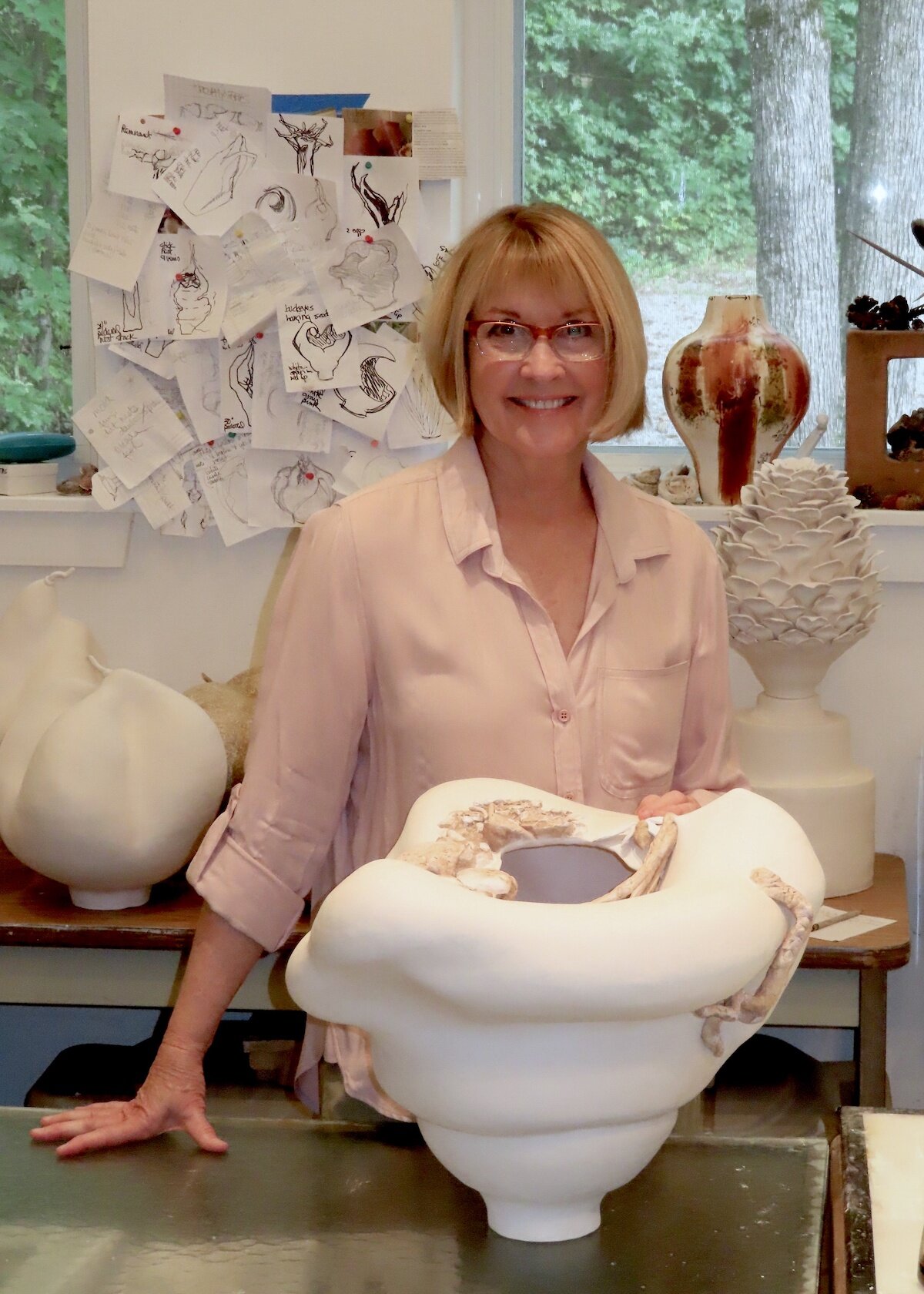Interview with artist Keith Runkle
Keith Runkle is not an Arkansas native, but like many who relocate here, he feels at home. Originally from Williamsport Pennsylvania, Keith received his BFA with a concentration in painting from Edinboro University of Pennsylvania. His work for nearly 30 years in graphic design comes through in his colorful, almost whimsical, oil paintings, which often tackle very uncomfortable subjects defused by humor. His art will make you smile, maybe even laugh – but always think. What more could you ask for? Keith’s work can be found at Boswell Mourot Fine Art at their soon-to-be new location in the SOMA (South Main St.) district of Little Rock, at his website runkleworld.com, and at his Facebook and Instagram.
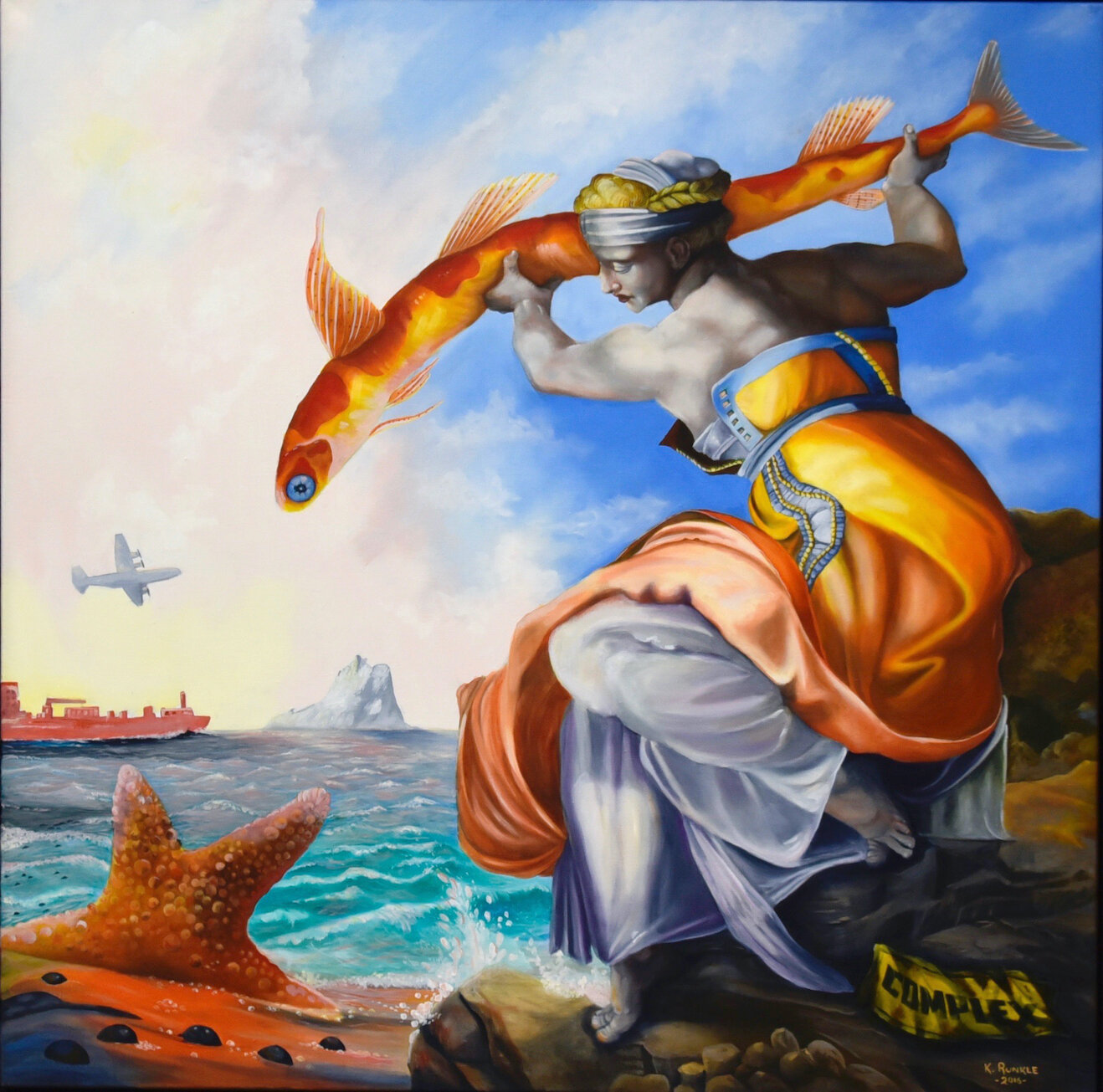
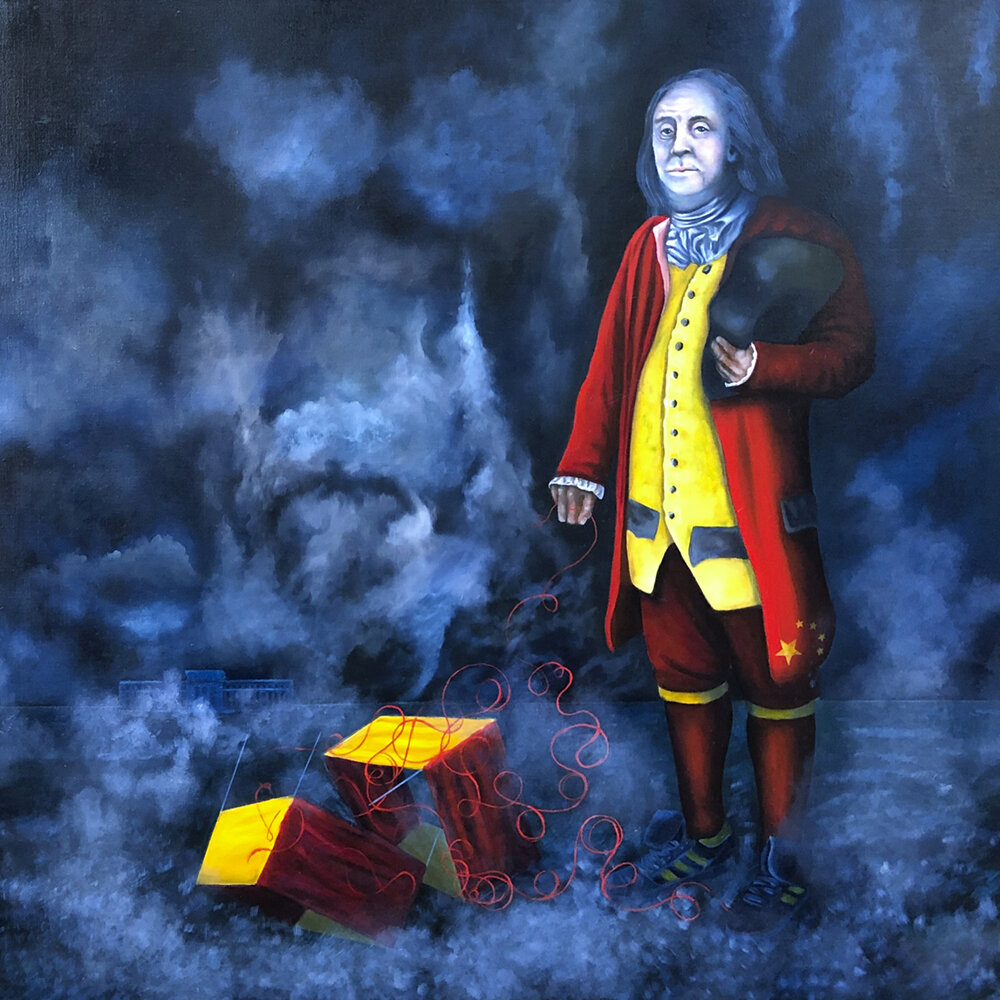
AAS: You are originally from Pennsylvania. What brought you to Arkansas?
KR: I grew up in one of the most breathtakingly beautiful parts of the country. Beautiful enough to make the most hardened person cry. I hated it there. It’s cold. I don’t do cold. I grew up in a drafty farm house sitting on floor vents drinking hot beverages. Though it was God that led me to Arkansas, it was ultimately Little Rock and Warren’s Pink Tomatoes (and my bride who introduced me to those tomatoes!) that have kept me here. I love Little Rock!
AAS: You have won awards as a graphic designer including several American Advertising Awards (used to be called the Addys) and now you are designing jewelry. Is design something you have always been interested in?
KR: I was blessed with a God-given ability, and from a very early age I began drawing...and I just never stopped. It was as natural to me as breathing. I was “that kid” who sold my drawings to my elementary classmates! My love of art eventually led to me obtaining a BFA in painting from Edinboro University of Pennsylvania. Following graduation, I quickly realized that I needed to pay bills. This led to me landing in the printing industry...in a time that ended up bringing forth the birth of desktop publishing. I count myself as fortunate for having forged a 35-year career in graphic design. In addition to the mundane, I’ve also had the opportunity to work on many great projects with a lot of interesting people.
In recent history, my life took an unexpected turn into the world of jewelry making. I’ve always had an interest in jewelry, but that became a reality when I became friends with the owner of Hillcrest Designer Jewelry. I never imagined after purchasing a pair of earrings from him for my wife for our anniversary that it might one day become my vocation to create jewelry for clients of my own. What’s not to love? Each piece is a small sculpture made from raw materials from the earth. So cool! While it’s only a part-time gig at the moment, I’m hoping to go full-time in 2021.
“I use color to “disarm” people. I want people to walk up to my paintings and look at them.”
Edgar Allan No. Remembering The Parkland Shooting, oil on linen, 36” x 36”
AAS: I like the way you describe your most recent paintings as ‘an allegorical representation of a world gone mad’. I think they are really extraordinary. At first glance the imagery is humorous – but then becomes so powerful as the viewer begins to understand its intended meaning. Edgar Allen No. Remembering the Parkland Shooting is one of my favorites.
KR: Thank you. I use color to “disarm” people. I want people to walk up to my paintings and look at them. Once they get there, I want to challenge them to think about what I might be thinking about. I don’t care if someone agrees with me necessarily, I just want a subject to be considered. I use a lot of symbolism to lead someone’s eye through the narrative and leave enough room so the observer can draw their own conclusion. Violence has become such a part of American culture. It’s been particularly unsettling to witness repeated violence committed in what should be considered one of the safest places on the planet – the school. For me as a parent, it has really given me pause. At the time of the Parkland shooting, my younger daughter was in high school. I couldn’t help thinking about what the parents who lost their children were feeling. So awful. Yet people just move on. I painted Edgar Allen No to remind people NOT to forget. I similarly addressed the 2012 Sandy Hook Elementary School shooting on not one, but two canvases. My son was in first grade at the time it happened – the same age as the children whose lives were so senselessly cut down.
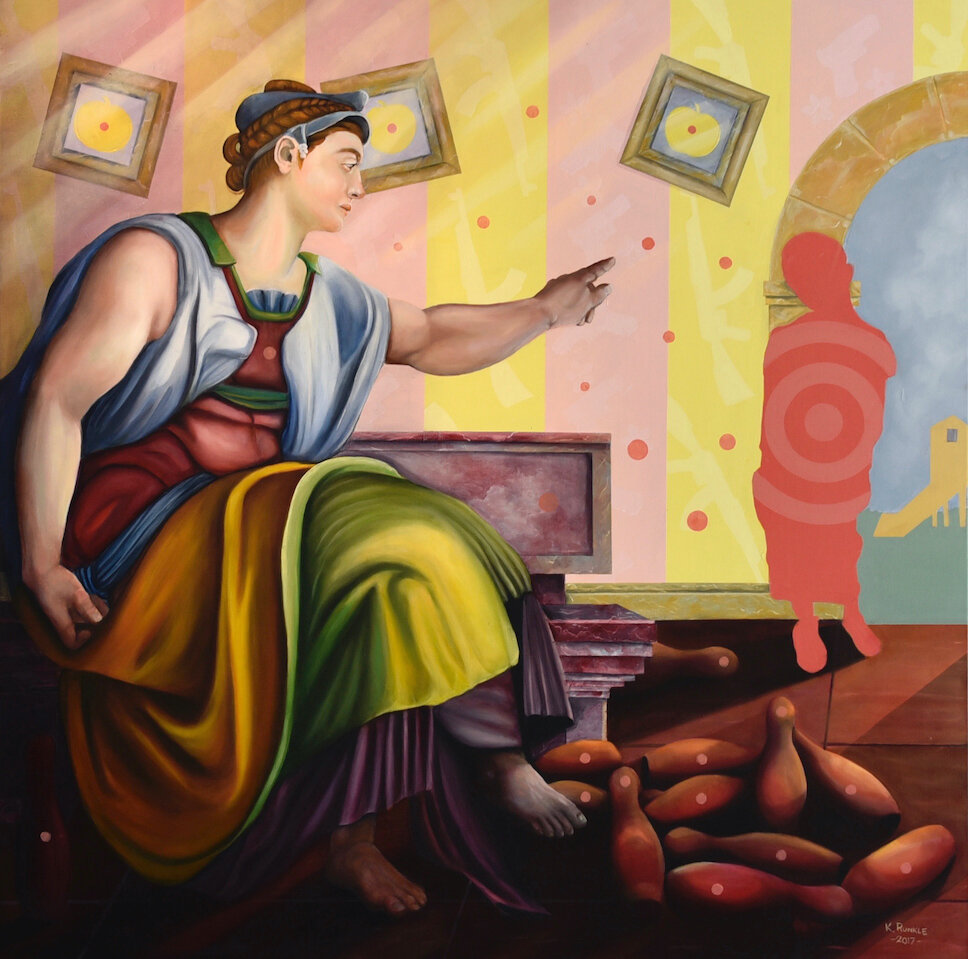
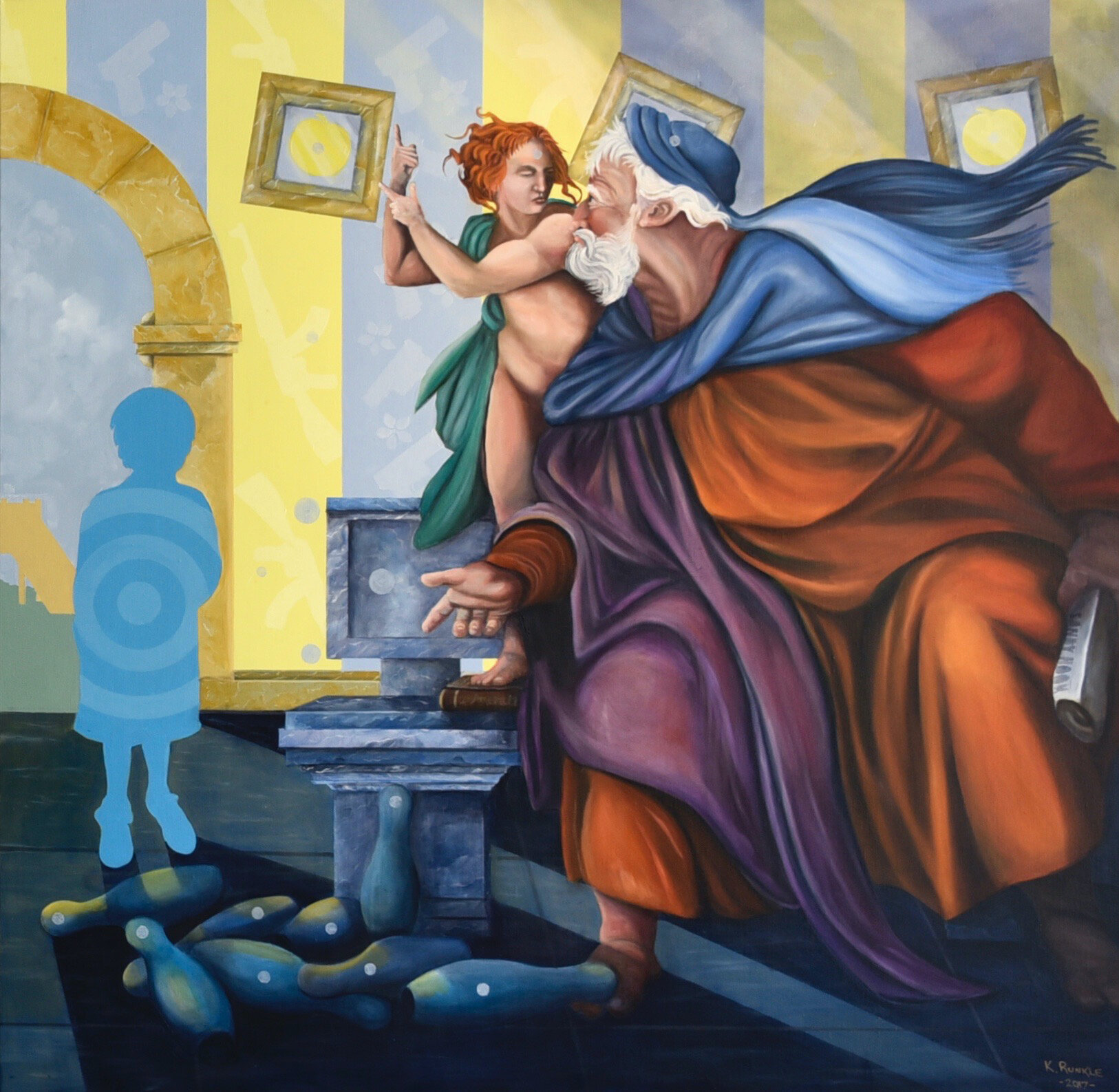
AAS: Has your work in graphic design and advertising helped you navigate the public’s reaction toward humor and the too often horror of current events?
KR: I think so. We often see this in advertising. Think about Pepto Bismol. They use humor (a funny jingle) effectively to “move” from one side of a difficult subject to the other, so to speak.
Sometimes when a subject is “heavy,” it’s in our nature to bury or avoid it. For me it’s just healthier when people can get to a place where they’re able to talk about or even laugh about the most divisive topics. I’m a firm believer that most anything can be solved over a cup of coffee. With that being said, even if something isn’t solved, a dialog has been created. My hope is that my paintings foster that by generating a dialog between the artist and the viewer.
“I like taking characters out of context. It creates tension – and humor.”
AAS: How much time does it typically take for you to develop a concept for a painting.
Ice Frogging, oil on canvas, 20” x 16”
KR: I usually have about three to four painting ideas in my head at any given time. Execution though, takes about six to eight weeks depending on how much life is being lived. I don’t paint as a vocation, so I do it when I can, which means evenings and any available time over weekends. The pandemic and other distractions this year made this year less productive than normal for me. Emotionally I’ve just struggled to get motivated. Over the last couple of years, I’ve been producing a painting every six to eight weeks. This year I’m way behind. I’ve been picking up steam in this second half of the year, so hopefully you’ll be seeing a lot of new work in the months ahead!
AAS: Who are some of the artists that inspire you?
KR: Salvador Dali is largely responsible for me becoming a painter. I would say he has been my greatest influence. He had a weird way of looking at his world which inspired me to look at mine my own way. He was unapologetically strange.
In more recent years there are a number of artists whose careers I follow and admire including pop surrealists Mark Ryden and Ron English. Graffiti artists KAWS, Shepard Fairey, and Greg “Craola” Simkins are fantastic. I really love the whole lowbrow movement that came out of LA. I also love Kehinde Wiley, Amy Sherald, and Yinka Shonibare. I could list so many more. There are so many great artists in this world!
If I Were A Fly On The Wall, oil on canvas, 48” x 60”
AAS: I really love the way you use ‘characters’ and ‘poses’ from Michelangelo’s Sistine Chapel and references from other biblical paintings.
KR: I like taking characters out of context. It creates tension – and humor. The characters I used from the Sistine Chapel in the painting If I Were a Fly on the Wall was from a section illustrating the prophets and sibyls. The subject matter I was dealing with in this painting required a “voice” of warning. Pulled from the ceiling of the Sistine Chapel, Isaiah attempts to expose selfish ambition within the religious community.
I really love the expressive nature of the Renaissance period, and if not using an actual character, I’ll often use a pose that I’ve seen in a painting from that period. I’ve done a number of paintings using this section of the Sistine Chapel to talk about what’s happening in current events. I do this mainly because it illustrates the connection between history and present day.
I Don’t Normally Draw Cyclops But When I Do They Wear Gucci, pencil on toned paper, 10” x 6”
AAS: You can’t help but smile looking at your drawings. Are these intellectual caricatures something you have always done?
KR: I’ve done these characters for as long as I can remember. I’ve doodled my whole life, much to the chagrin of past educators and work supervisors. I was always drawing cartoon characters as a kid and as my world matured, so did the characters.
These characters have helped me survive nearly every meeting I’ve ever had to endure (I’m self-diagnosed ADD). When I draw, I have near perfect retention during required work meetings. When that’s taken away, my mind tends to drift to faraway places. I’ve been fortunate that most of my supervisors over the years understood my need to do this (although a few – well, not so much!). Doodling is truly an effective way of letting the boundaries go.
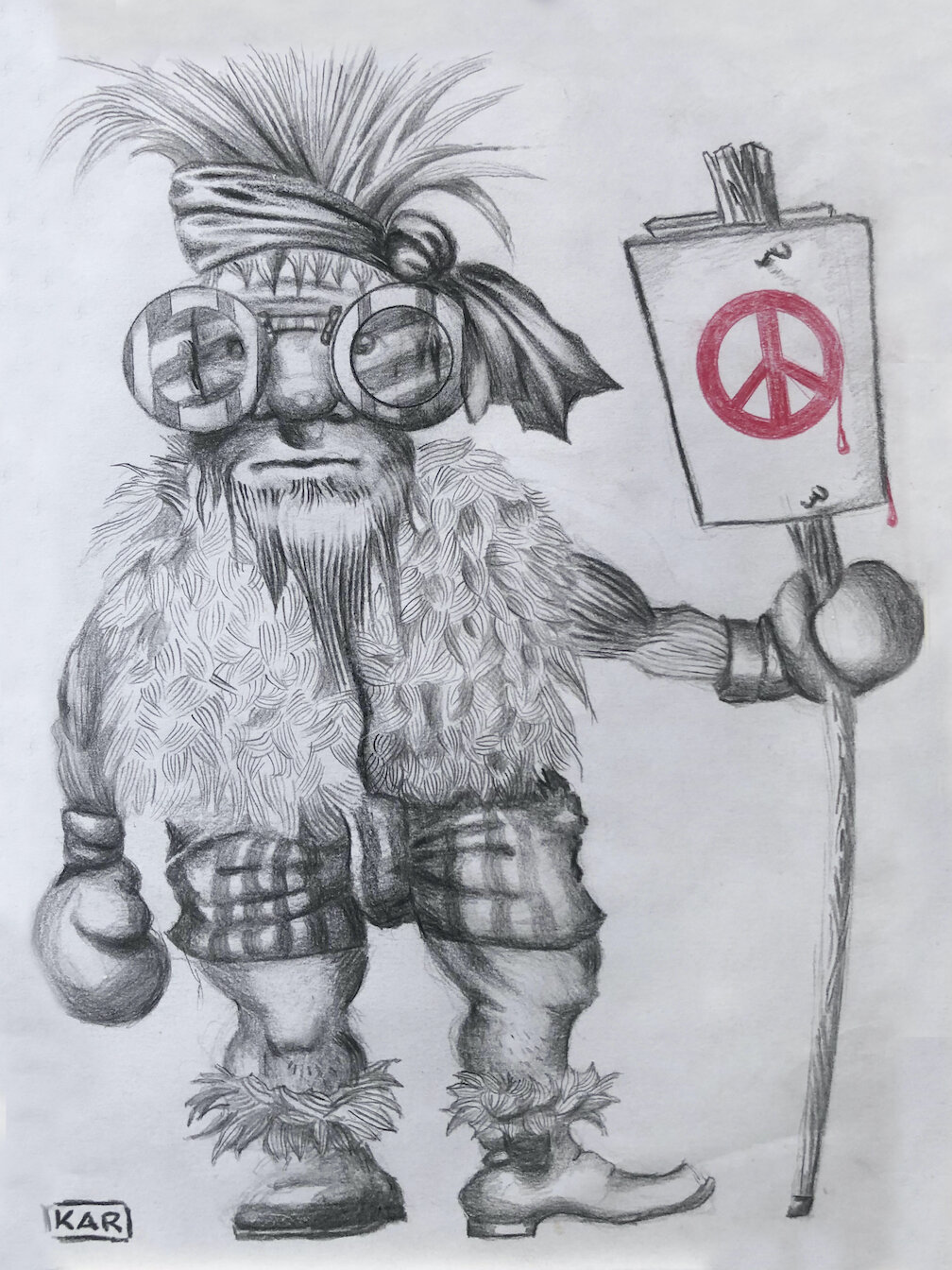

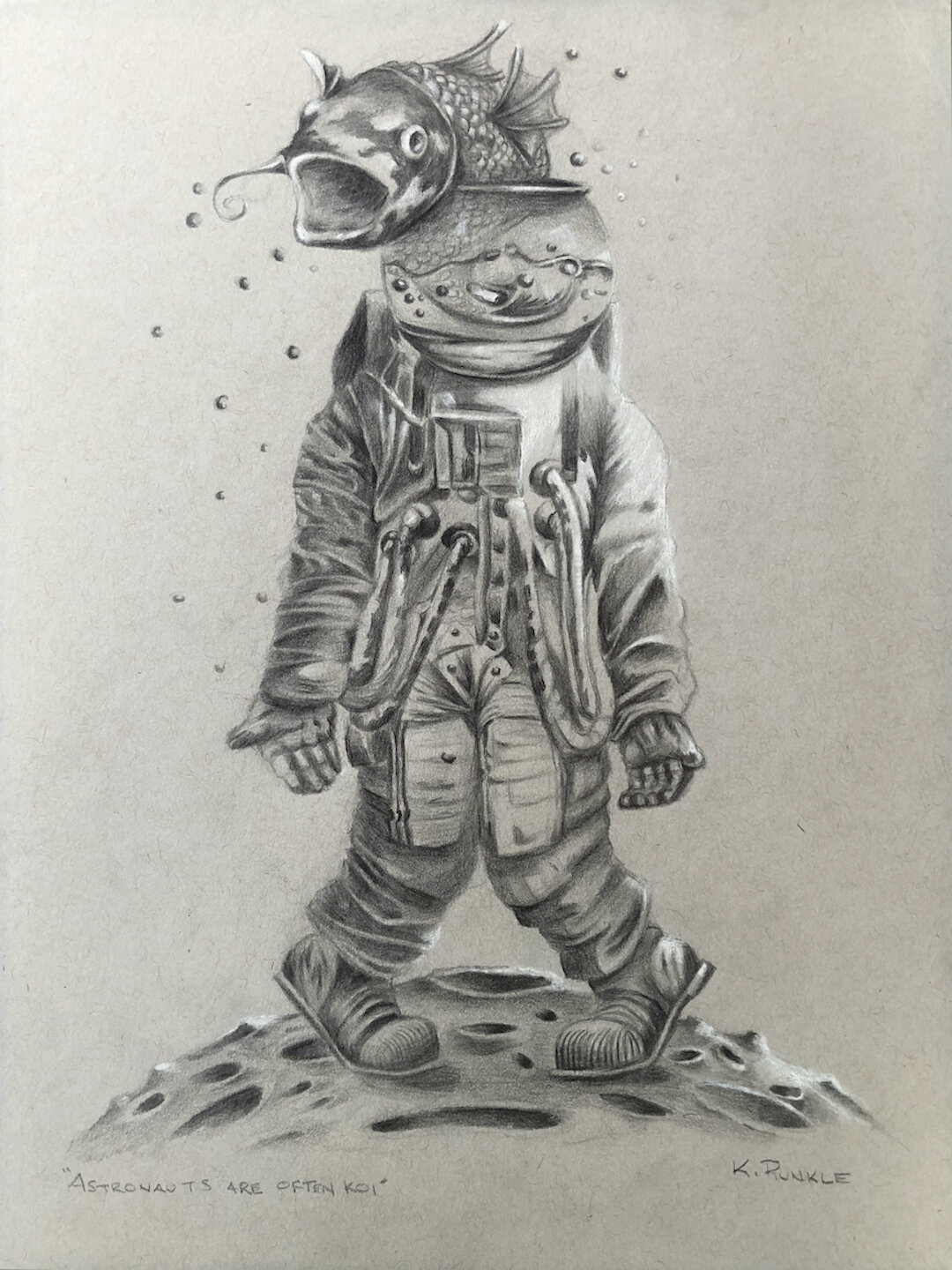
AAS: Keith, I don’t think I have ever asked this question: who are you painting for? Who do you see as your audience?
KR: Great question. First, I paint for me. I think to some degree this may hurt the marketability of my paintings. I’m not painting so that someone can hang my work on their wall. I’m painting because there are things I want to say and I think painting is a powerful way to say those things. With that being said, I do try to consider that someone is going to look at my work. So, I place a lot of consideration into how things are composed so that the audience (everyone else) won’t be bored with what they see and at the same time can be challenged by the subject matter. My goal for the audience is that I would be a competent painter.
Peace Is Always Late To The Party, oil on linen, 20” x 20”
AAS: Peace Is Always Late To The Party is filled with subtle and not-so-subtle imagery. Would you talk about that work?
KR: This work was inspired by a thought I had that we often put something as fragile as the peace process into the hands of men of war. The VW Beetle in this piece represents peace and the warrior about to enter its door would be completely out of place behind the wheel of it. Oblivious to the dead body he’s stepped over to get there, he really has nothing in the way of peace to offer anyone. It’s just not in his nature. It’s not who he is – and then there is the tossed off vanity plate.
AAS: I just have to think that there is a lot of laughter at your house. Has humor helped you and your family get through the current craziness we are all living now?
KR: One would think so, but we are as neurotic as every other household in the city. Don’t get me wrong, we laugh and find humor in the most absurd and irreverent things, but 2020 has been a challenge! I would say that humor is an important component in any family navigating the day-to-day grind. When it’s missing, it can really be a challenge to endure life’s trying times. This year we’ve probably needed to laugh more. It’s been especially difficult for reasons other than COVID.
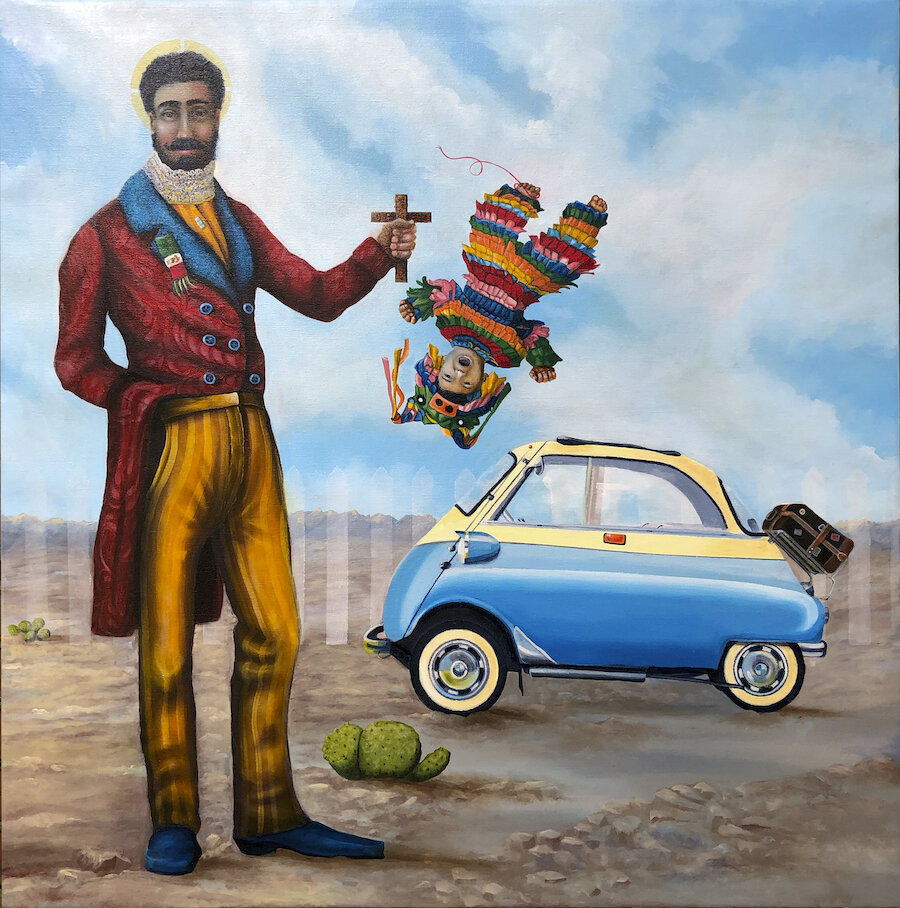
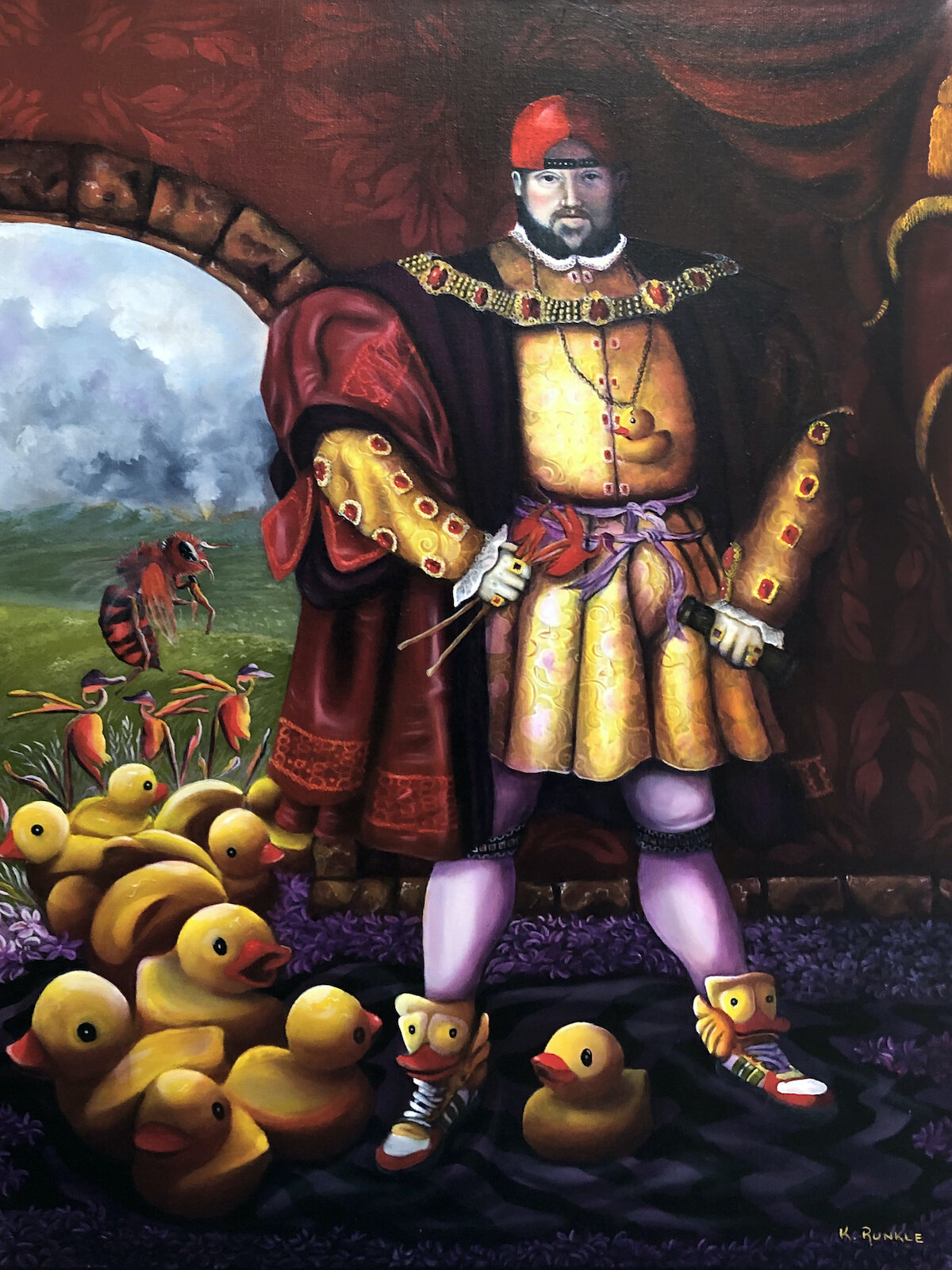
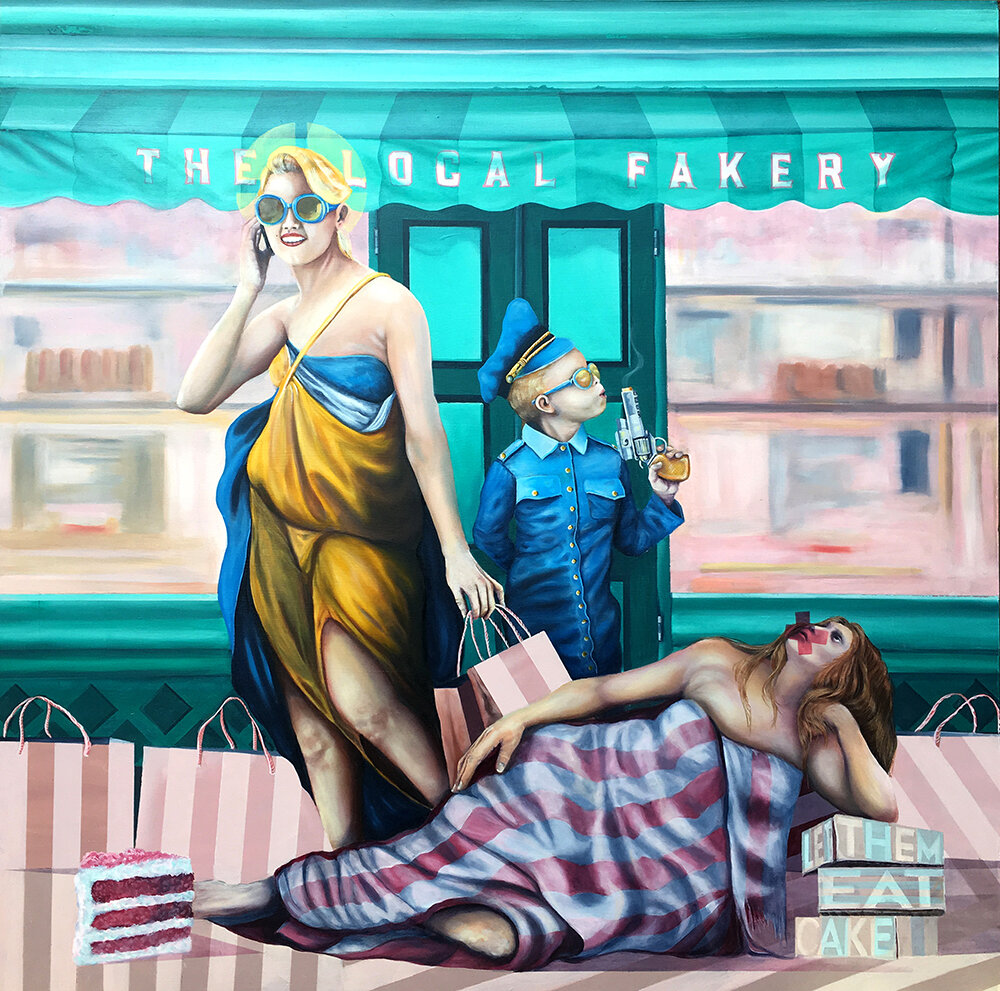
AAS: Any plans for some COVID paintings or any of the other crazy social/political events happening now?
KR: I will definitely do something related to COVID. How could I not? It has all the makings of the horror movies I grew up watching...kind of like a giant, radioactive ant devouring city after city. I haven’t had the idea yet because it’s just too big...and still too current. I’m working on a painting now that I’m close to finishing. It involves the dismembered head of a popular icon. I’m not sure it’s necessarily one that will hang above the mantle of a “normal” American home, but hopefully someone out there will appreciate the meaning behind the imagery.
Keith in his ‘hub’ studio.
AAS: Do any of your children have an interest in becoming artists?
KR: No one in my home aspires to follow in my footsteps. They are very supportive though and will often critique my work along the way to completion. “Hey dad, that guy looks like he has a pig nose!” I paint in our kitchen (a.k.a. the hub) so I guess it’s fair game. I began doing this when my kids were younger and I’d be called in from my studio to mediate their disagreements. Now that my daughter is in college and has moved out of our home, I suppose I could move back out to the studio, but I have just gotten used to painting in the kitchen – and I like being connected to my people.

